The Bay Trail Preview: Intel Atom Z3770 Tested
by Anand Lal Shimpi & Brian Klug on September 11, 2013 12:00 PM ESTOur Windows performance analysis takes place on Intel's Bay Trail Form Factor Reference Design. The 10-inch tablet features a 2560 x 1440 display, 2GB of LPDDR3-1067 memory and a 64GB eMMC solution. The platform was running Windows 8.1 (32-bit).
Intel left me to install and run anything I wanted to during a period of a few hours at their campus in Santa Clara. I got a feel for the speed and snappiness of Bay Trail during my benchmark setup/installation process. While I don't believe Clover Trail was really usable in Windows 8's desktop mode (it was just too slow), the same is definitely not true for Bay Trail. With the exception of a few benchmark installs or loads that simply took forever, my Bay Trail experience was really quite good under Windows. Bay Trail is obviously not as fast as Haswell when it comes to general usage, but it's definitely worthy of a discussion. Whether or not it actually is good enough for an entry level machine will depend on how OEMs choose to configure their Bay Trail systems. I'll hold off on a final verdict here until we have some time with final Bay Trail devices and not just FFRDs.
Intel already teased the Atom Z3770's multithreaded Cinebench performance, but what about single threaded performance? Remember that single threaded performance is often a signfiicant contributor to things like application responsiveness.
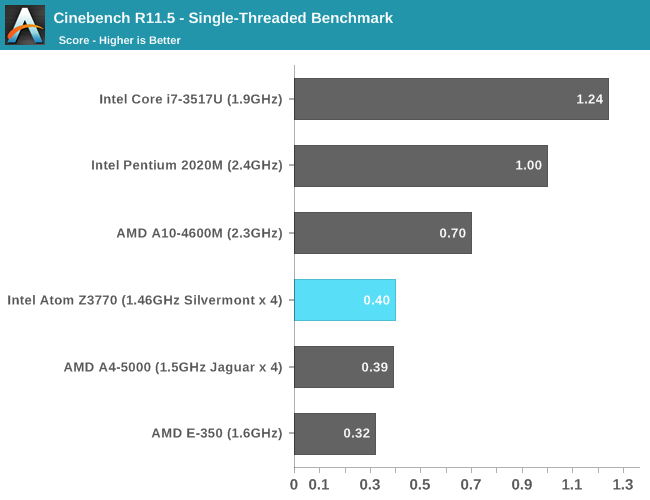
The single threaded performance numbers are just barely ahead of AMD's Jaguar based Kabini SoC. The big difference however is power. I had Intel measure SoC power at the board level while running a single threaded Cinebench 11.5 run on the Atom Z3770 and saw a range of 800mW - 1.2W. AMD on the other hand lists the A4-5000's SoC/APU idle power as 770mW. I don't have equivalent data for AMD, but with the A4-5000 idling at 770mW, it's safe to say that SoC level power consumption is lower on Bay Trail. The A10-4600M/Trinity comparison is interesting as it really helps put Bay Trail's performance in perspective as well.
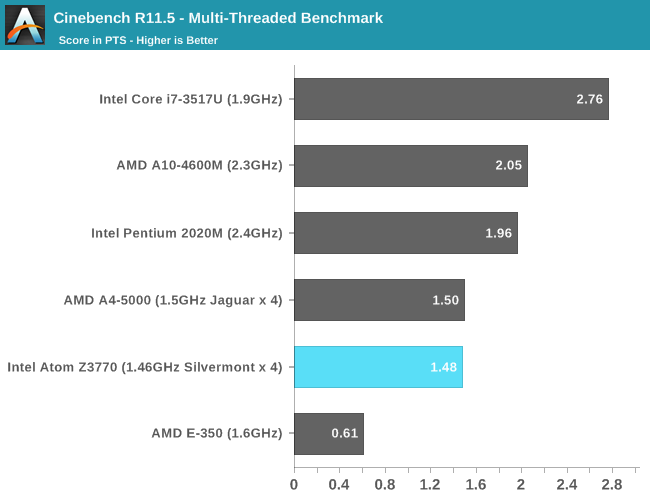
Multithreaded performance puts Bay Trail and AMD's Kabini at similar performance levels. Once again, looking at SoC power however the Atom Z3770 pulls around 2.5W in this test. Looking at the increase in platform power for the A4-5000 here, I'm assuming that the equivalent data for AMD would put Kabini in the 6W range. Multithreaded performance comes very close to the Pentium 2020M, but that's really overstating the strength of Bay Trail here as the Atom Z3770 has twice as many cores as the Pentium 2020M.
Single threaded integer performance is likely more useful to know, especially given Bay Trail's target market. For a rough idea of what to expect there, we turn to 7-Zip's built in benchmark. The dataset footprint is large enough to require main memory accesses, making this benchmark a little more interesting than it otherwise would've been. I unfortunately don't have access to all the CPUs here, so the 2C/4T 1.9GHz Core i7 3517U turns into a 2C/4T 1.7GHz Core i5 3317U as it's the only comparison data I had handy:
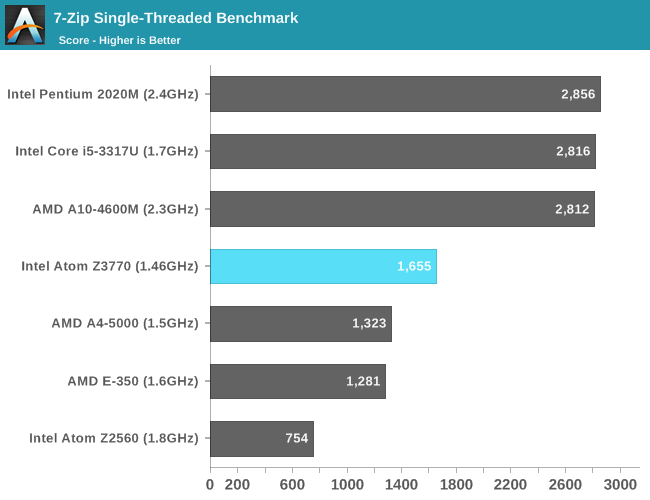
While Silvermont's single threaded FP performance seemed identical to Jaguar, its single threaded integer performance is much higher in the 7-Zip benchmark. Here the Atom Z3770 is 25% faster than the A4-5000. Looking further up the list however, there's still a healthy gap between thermally constrained Ivy Bridge Ultrabook class parts and the best Bay Trail has to offer. In this case Surface Pro's silicon is 70% faster than Bay Trail. Depending on your perspective that's either a huge difference or remarkably small given how wide the previous Atom to Core gap was.
7-Zip also features a multithreaded benchmark. Here we're looking at the same workload, but now split across all available cores/threads:
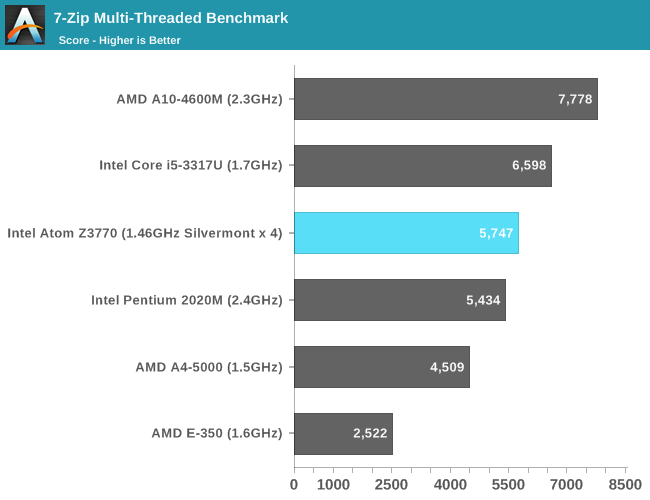
In multithreaded integer workloads, the Z3770 gets dangerously close to Ivy Bridge levels of performance. Again, we're overstating Bay Trail's performance here as the Z3770 has four cores while the Core i5-3317U only has two (but with Hyper Threading presenting another 2 virtual cores). I don't believe most tablet workloads are heavily threaded integer workloads, however the world is hardly single threaded anymore. The reality is that a quad-core Bay Trail should perform somewhere between 40% - 80% of a dual-core Ivy Bridge.
For what its worth, Bay Trail SoC power during the multithreaded 7-Zip benchmark was between 1.9W - 2.5W. At this point there's no question in my mind that Silvermont and Bay Trail are truly tablet-class power consumers.
Our next tests are browser based benchmarks that, once again, hope to characterize Bay Trail's performance in a manner that's more representative of lighter client workloads:
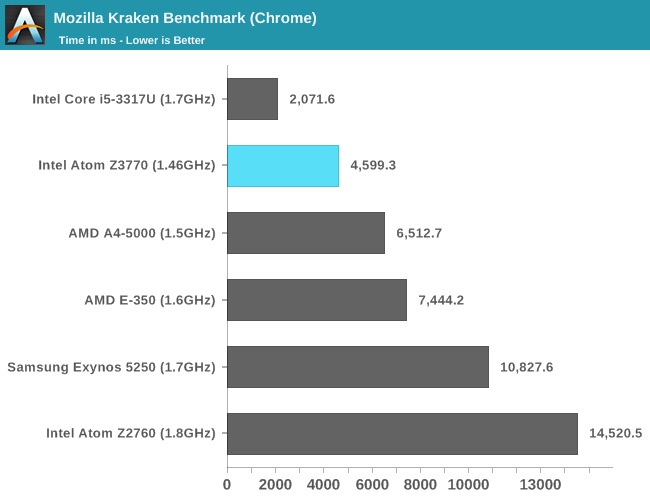
The Silvermont vs. Jaguar comparison shows a 29% advantage for Intel. Looking back at Clover Trail vs. Bay Trail, the performance improvement is staggering. Intel improved performance by over 3x at this point. The 17W Ivy Bridge vs. Bay Trail comparison continues to be interesting. Here the Core i5-3317U completes the Kraken test in half the time of the Atom Z3770.
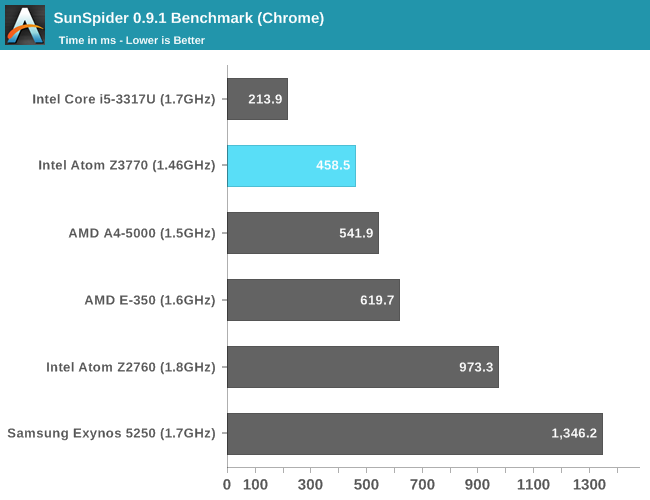
The Silvermont/Jaguar gap in SunSpider shrinks a bit in SunSpider. Bay Trail is still over 2x faster than Clover Trail, and Ivy Bridge remains over 2x the speed of Bay Trail.
For our final light CPU workload test we have PCMark 7. This is an interesting benchmark as it takes into account the storage subsystem a bit. Keep in mind here that the Bay Trail system is using eMMC based storage, while all of the others are using a standard SSD (Samsung SSD 830):
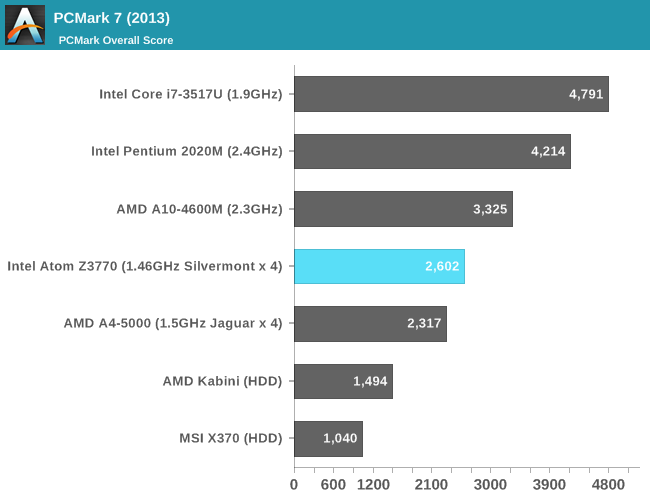
As we saw earlier, Bay Trail can make up for its single threaded performance by doing quite well in multithreaded tests. PCMark 7 attempts to present a mixed workload view of Bay Trail's performance and the result is relatively similar to AMD's Jaguar based A4-5000 Kabini APU. AMD's Trinity ends up being just under 30% faster than Bay Trail, while 17W Ivy Bridge is 60% faster. Overall platform performance is definitely not bad at all as long as the OEM does a good job specing the device. In this case the Samsung eMMC solution in the Bay Trail tablet reference design was surprisingly decent.
GPU Performance
Arguably the more interesting CPU and GPU tests will come in the Android section but I borrowed some Android data from our Kabini review and ran through 3DMark, GFXBench 2.7 and some lighter Steam games:
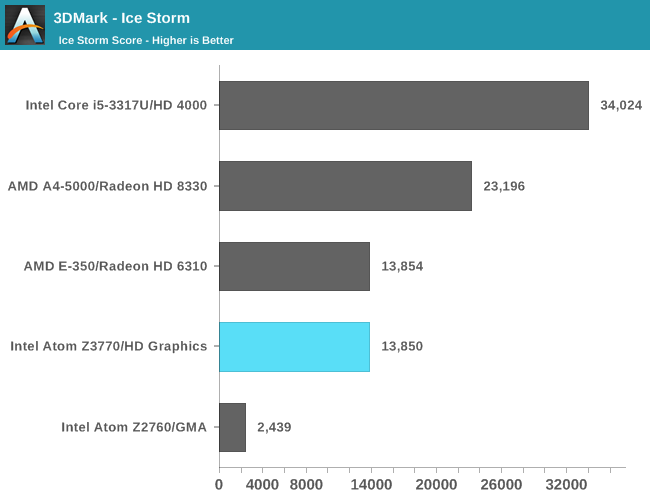
Bay Trail's overall 3DMark Ice Storm score (720p) is about on par with Brazos rather than being a competitor for Kabini. Bay Trail's HD Graphics core is based on Ivy Bridge and it's a cut down implementation at that.
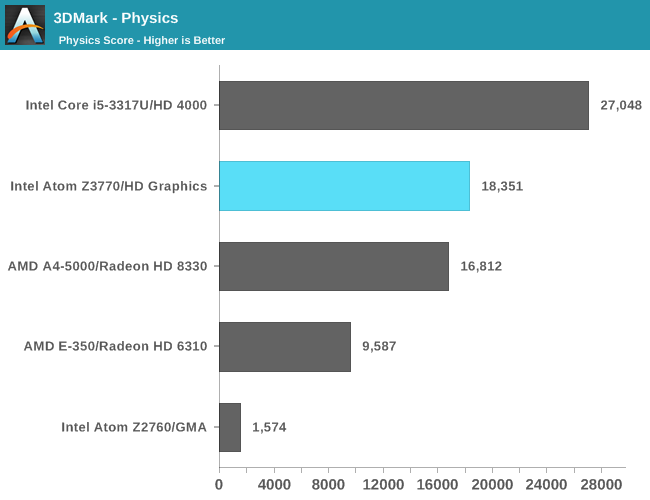
3DMark's Physics test is basically a multithreaded CPU benchmark, which allows the Z3770 to pull ahead of the A4-5000.
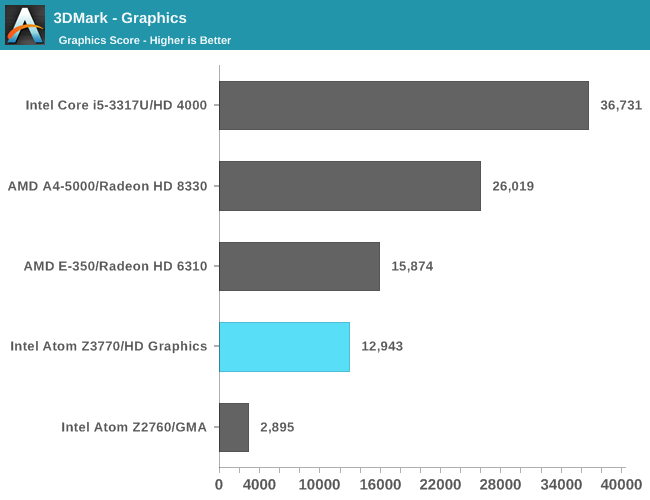
If we isolate graphics alone however, the Z3770 once again falls behind Brazos.
GFXBench 2.7's T-Rex HD test seems to agree with what 3DMark tells us:
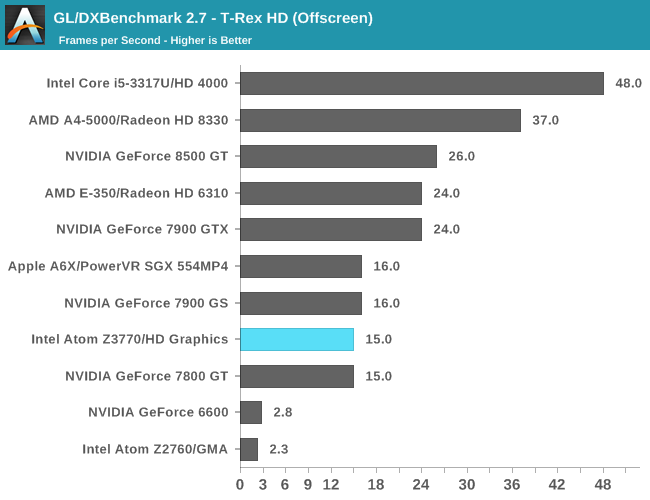
Obviously under Windows we have more opportunities to benchmark actual game performance. I turned to the lighter (1366 x 768, low quality) game benchmarks I ran for our HD 5000 comparison. I had to exclude Super Street Fighter IV as a driver problem kept it from running on the Bay Trail FFRD.
In a couple of cases Bay Trail delivers roughly half the GPU performance of a 2011 11-inch MacBook Air, but in a much lower power package. Minecraft saw a bigger gap at 1/3 the performance. None of these games are really playable, but that doesn't mean others aren't. I was able to play Team Fortress 2 on Intel's Bay Trail FFRD (with a Bluetooth keyboard and mouse of course) at reasonable frame rates. The system would chunk occasionally but for the most part it was relatively quick. Obviously Bay Trail's graphics are better suited for lighter tablet games.
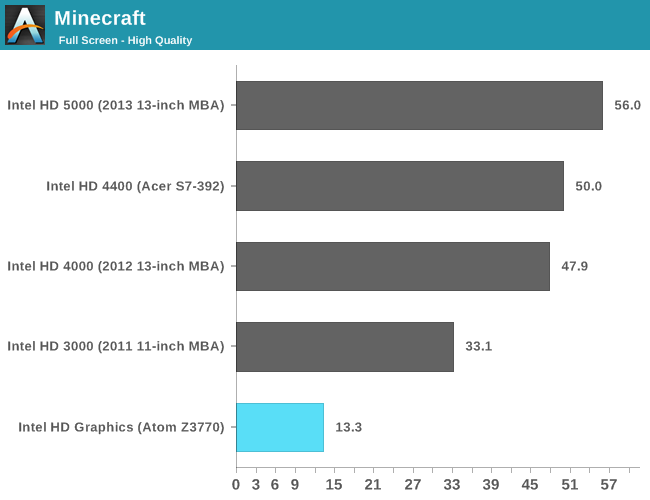












190 Comments
View All Comments
zeo - Saturday, September 14, 2013 - link
Sorry but nothing you just said changes anything I stated! The Smartphone market has no real use for HSA or hUMA and until it does then there will be no real push to adopt it.Problem is there's more widely accepted standards already available and what AMD is pushing only really benefits their hardware! Really, HSA is not limited to what AMD is trying to establish... they just want their solution to become the defacto standard but that's easier said than done!
AMD won't even add discrete GPU support until sometime next year. So you're stuck with limited APU's right now for example!
So this isn't even a finished standard they're trying to push!
Right now the main interest is in the server market, where custom software is common and it's a lot easier to push a new proprietary solution and that's the main reason why ARM and it's many partners are interested in it...
Problem is for this to really take off it needs to appeal to the general consumers but like CUDA, applications are few and far between right now...
Sure, there's potential but there's nothing to suggest yet it will succeed any more than CUDA did and that has been around a lot longer!
Though, it does benefit AMD in that they can easily swap out their x86 cores for ARM cores and still offer HSA, etc... So gives them some much needed diversity and flexibility as they continue to push their solutions to market...
teiglin - Wednesday, September 11, 2013 - link
One thing that would be nice to see in the charts is max turbo clocks as well as nominal clocks where relevant. You list all parts with nominal frequencies, which makes it hard to get a handle on per-clock performance. Off the top of my head, I know that the i7-3517U is going to have max turbo around ~3GHz and that the Pentium 2020M has no turbo, but I had to go look to see that the trinity part listed has a 3.2GHz turbo.Of course, that doesn't really get into the discussion of how much time each CPU really spends at those turbo clocks--that is obviously a more nuanced point, which I'd love to see you guys investigate as it changes with chassis/cooling design and probably other vendor-specific settings--but it'd still be helpful as a basis for comparison. And of course if you ever include ARM chips in those charts, which generally include unsustainable max clocks (and no listed TDP).
TheinsanegamerN - Wednesday, September 11, 2013 - link
this. the 4600m has some very interesting turbo issues, often dropping below base clocks when any power is sent to the gpu. and, was this atom boosting the whole time, or was it running at its base clocks?Shivansps - Wednesday, September 11, 2013 - link
What i whould like to see is the E-350/E450/E2-1800 being added in the games comparison, the HD63xx based may be more powerfull, but in games the IGP could not get the most of it because of crappy CPU performance and lack of memory bandwidth of Brazos.nitrousoxide - Wednesday, September 11, 2013 - link
Another design by Intel with an overpowered CPU and an underwhelming GPU? This thing should have at least 6EUs to be competitive. And those two extra cores aren't really necessary since you can't expect a tablet to be productive. Why don't they make it 2C+6EU?However Bay Trail is really going to put the last nail in the coffin on AMD's mobile strategy. AMD's only advantage here is a way faster GPU but only on 15W/25W Kabini parts. The 3.9W Temash is clocked at 225MHz which put it on the same level as HD6310 and thus the GPU is at best as slow as the 4EUs that Bay Trail has. AMD now has nothing competitive even though Kabini/Temash is a massive improvement over Brazos.
Shivansps - Wednesday, September 11, 2013 - link
I think we need to compare IGP performance in actual games, as i was saying, for example the HD6310 performs quite well in benchmarks, and yet still get beaten by HD2000 in some games because the slow cpu and memory bandwidth was not helping at all. Bay Trail Atoms need to be compared to Brazos, Temash and Kabini in games, benchmarks may lead to have a wrong impresions here, i think it may able to beat brazos in some games.jason404 - Wednesday, September 11, 2013 - link
Will Bay Trail have Intel WiDi support?Hopefully there will at least be Miracast support on the eventual Bay Trail powered ThinkPad Tablet 3. Can't wait!
zeo - Wednesday, September 11, 2013 - link
Yes, Bay Trail Support WiDi... Miracast, etc... It even support features they normally disable in low end GMA's like Quick Sync...It may still be low end performance but it's a significant upgrade from the previous ATOM in pretty much every respect...
Anders CT - Wednesday, September 11, 2013 - link
The performance looks really good. It was about time Intel entered the fray.That being said Bay Trail faces a number of obstacles to be accepted in mobile space.
1) Bay Trail executes the wrong instruction set. Android is the new Windows, and making it work on the Bay Trail is critical for the SoCs succes. And while porting the Android software stacks to x86 is doable it is not trivial. The user of a Bay Trail device might not be able to download every app from the Market. Why doesn't Intel just make it an ARM SoC?
2) Price. A Tegra 4 or Snapdragon 600 SoC can be had for less than 20$. Will Intel compete at this price-point? That would be very unlike the Intel we know.
3) Other parts of the SoC: Krait and Cortex cores can be combined with on-chip dsp processors, radios, various controllers and other stuff. The appeal of an Intel SoC will be lessened, if it requires one, two or tree external chips to be added to the design. Qualcomm SoC's are very succesful in part because they put so much in a single package, leading to a simpler and less expensive board.
zeo - Wednesday, September 11, 2013 - link
Actually, Google officially supports Android on x86... Intel devices have been getting the latest Android release for the past year!For Medfield and Clover Trail+ they just added a Binary Translation layer to ease compatibility with Native, ARM optimized, apps... which are mostly games... While Google support means they also updated all the SDKs so developers can easily develop for both platforms and support for Intel devices has improved significantly over the last year.
Just look up early reviews when Intel ATOM based Android devices first came out a year ago to more recent ones and you'll see most apps run fine now...
While Silvermont supports virtualization extensions and that can be used to accelerate some Binary Translation and similar operations for better performance for non-x86 optimized native apps... combined with the better performance should make for a much more comparable experience... Mind, with Android apps being mostly hardware agnostic, Intel started with over 90% compatibility and that has only improved as developer support has grown and will continue to improve if Intel keeps on gaining market share in the mobile market...
It also helps they're going to start pushing Android on traditional PC systems, many running Android on the Intel processors... So that'll help boost developer interest in x86 support...